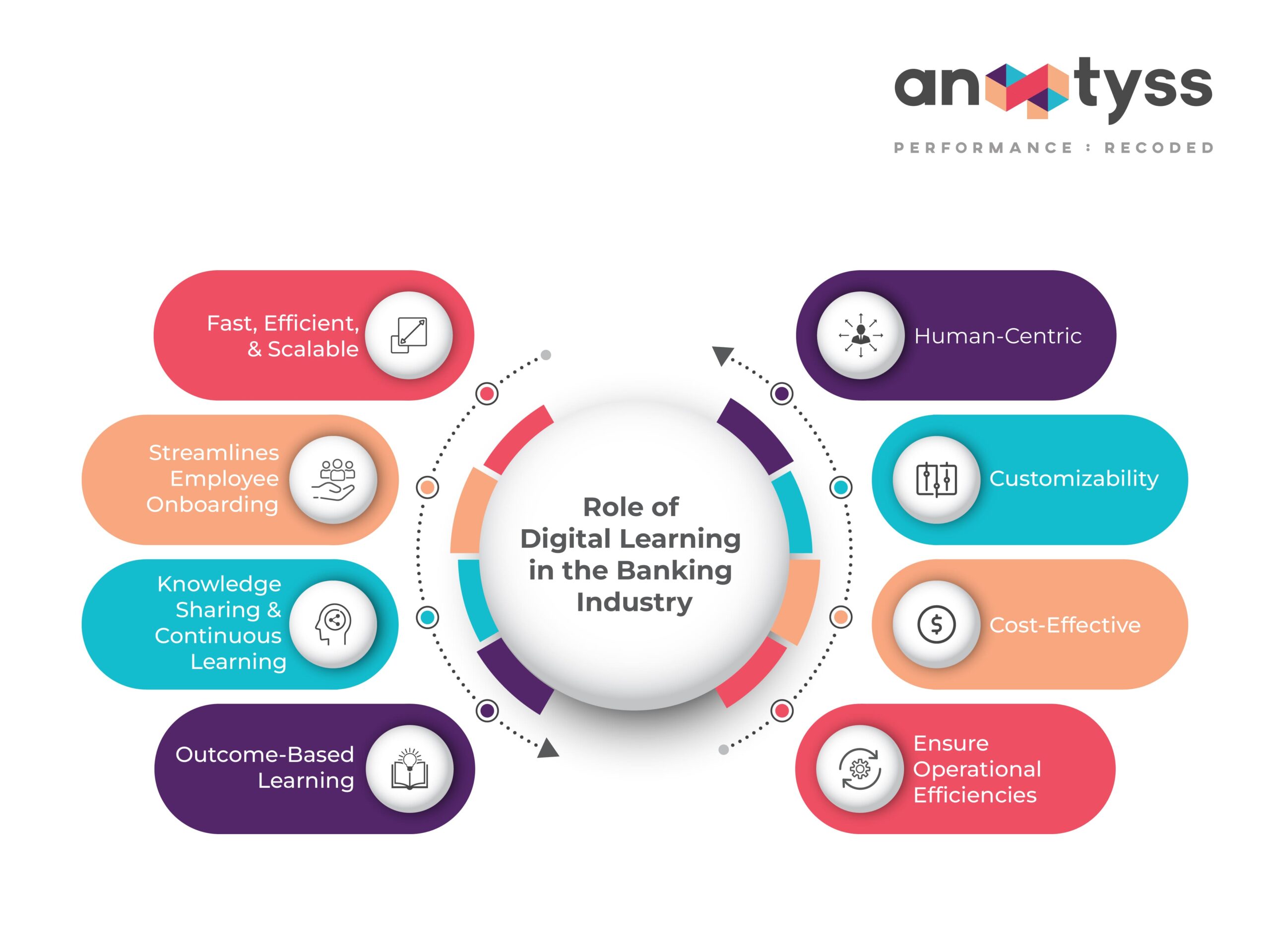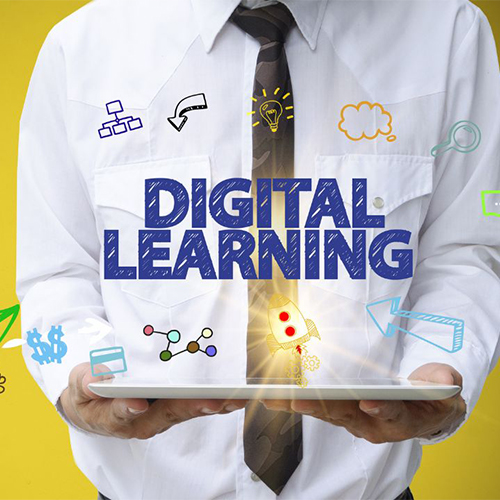In this blog, learn how digital learning can enhance workforce skills in banking, offering flexible, scalable, and cost-effective training. Discover strategies for efficient claims management, regulatory compliance, and operational risk mitigation through advanced technologies and continuous upskilling.
Banking and financial services are transforming due to technological disruption, changing customer preferences, and regulatory shifts. While financial institutions are looking to adopt digital solutions and optimize processes, they know their workforce (or talent pool) is the key to navigating the change.
Employee training is a recognized way for workforce skilling; however, organizations including financial institutions, now look for more effective learning approaches that can allow:
- Rapid skilling: Faster onboarding and transition of new talent to production
- Flexible training: Supporting individual preferences for inclusion and engagement
- Scalable learning: Ramp up/ramp down programs to support batching
- Measurable outcomes: Ability to track, measure, and report the learning outcomes
How does Digital Learning Support Workforce Training in Banking?
Digital learning or e-learning can help banks augment their workforce skills and build hands-on execution capabilities within a few weeks to months, as follows:
1. Flexible and Scalable Training
Digital learning offers more choices to upskill and reskill workforces on niche processes:
- It allows employees to have 24/7 access to learning materials from anywhere
- Employees can follow their learning paths at their own pace
- It also streamlines the learning process by defining focused training roadmaps
According to the PwC report – a substantial 46% of financial services CEOs worldwide say that significant retraining/upskilling stands as the most important initiative to close a potential skills gap. Digital learning platforms play a crucial role in addressing these skill gaps through upskilling and reskilling initiatives.
2. Employee Onboarding
- With digital learning, banks, and financial institutions can rapidly onboard onsite and offsite (remote) employees in different roles simultaneously.
- Banks can quickly streamline and organize required training programs, assign them to the employees and assess their performance more effectively.
Traditional employee onboarding methods typically face resource constraints in terms of time, logistics, and costs. The digital learning approach can help banks transcend these limitations and save significant time and cost.
3. Knowledge Management
- Digital learning platforms boost the exchange of ideas and foster a collaborative and continuous learning culture.
- With a digital learning platform, employees can engage in discussions and group activities to exchange their ideas, experiences, and knowledge among themselves.
- It also encourages cross-department interactions where employees from different backgrounds can share their diverse perspectives and thoughts.
- They can also share their feedback on the content or learning materials that banks can use to continuously improve and refine their training materials.
- Digital learning also enables microlearning or bite-sized modules and resources to facilitate learning in short bursts and smaller timeframes.
- Another use case is the curation of domain expertise in the form of digital knowledge libraries; banks can digitize the rich process expertise of their operations teams and individuals and create specialized courseware to train and onboard new resources.
According to the PwC report – 44% of CEOs worldwide responded that they are missing their growth targets due to the ‘availability of key skills.’
4. Determine Operational Efficiencies
With tech-enabled learning, banks, and financial institutions can improve their processes by identifying, collecting, and distributing the knowledge when necessary, leading to smoother operations. Digital learning in knowledge management can produce significant outcomes to enable banks:
- Identify the skill gaps and accelerate training programs
- Faster onboarding
- Remote access regardless of location
- Faster understanding, acquisition, and application of new skills
- With minimal downtime, employees can continue to learn during breaks (at their own pace) without disrupting daily operations
Benefits of Digital Learning in the Banking Industry
The digital learning approach can support knowledge management and transfer by capturing, organizing, and sharing operational capabilities in the form of digital learning repositories (DLR). These repositories can be further updated by identifying the skill gaps, curating up-to-date content, and using digital learning platforms regularly (preferably every 6-months) to organize and structure the content for easy accessibility.

1. Outcome-Based Learning
Outcome-based learning program refers to defining specific learning outcomes or goals that employees are expected to achieve by the end of the onboarding, training, or upskilling program. They are designed to help employees acquire skills relevant to the current market and emphasize employee demonstration rather than curriculum.
It also provides them with insightful data on the progress and assessment of the employees that helps them keep track of and monitor the effectiveness of their knowledge management initiatives.
This further enables them to identify gaps and areas for improvement, ensuring meaningful long-term outcomes.
According to this L&D 2023 Workplace Learning Report, 25% of skill sets for jobs have changed by around 25% since 2015. By 2027, this number is expected to double.
2. Human-Centric
With digital learning platforms, banks, and financial institutions can efficiently deliver tailored content to new hires or existing employees based on their strengths and weaknesses for personalized and effective learning. It helps them retain top talents and ensure faster employee development. It further helps banks:
- Provide customized onboarding resources and self-help materials for new employees
- Leverage the organizational knowledge to identify the top talents
- Ensure a clear career advancement pathway for key talent
3. Customizability
Banks and financial institutions can personalize learning experiences to meet specific needs, preferences, and objectives. With digital learning platforms, banks can create a learning environment that resonates with their organizational business objectives and requirements of the diverse skill set of their workforce. It enables banks to:
- Create tailored content that aligns with their specific operation areas, such as investment, mortgage, retail or commercial banking, etc.
- Offer content in different languages or formats based on regions and adhere to cultural nuances or compliance requirements
- Curate and develop content for role-based learning, ensuring employees gain expertise relevant to their position
- Incorporate real-world situations for scenario-based training and offer employees a chance to critical thinking and problem-solving in a safe environment
4. Cost-Effective
Banks can reduce training costs by implementing digital learning or eLearning and replacing classroom training with online learning. It can help save on resources and eliminate the expenses related to printing materials, trainers, travel, or physical venues. It also helps banks:
- Accommodate a large number of employees for learning programs without adding significant extra cost
- Minimize infrastructure costs
- Reuse content repeatedly for new hires (with continuous improvement) and extend the value of the initial investment over time
- The more employees engage, the less it costs per learner – economies of scale
89% of L&D pros agree that proactively building employee skills will help navigate the evolving future of work
Conclusion
Digital learning can help banks upskill the workforce, manage knowledge, and onboard new talent. A digital learning solution such as Fluent™ addresses workforce training and knowledge management through tailored courseware, digital knowledge libraries, and built-in analytics.
Interested in learning more about our digital learning solution? Connect with Us: info@anaptyss.com.



